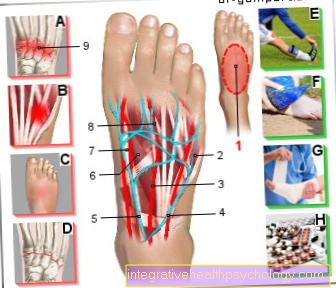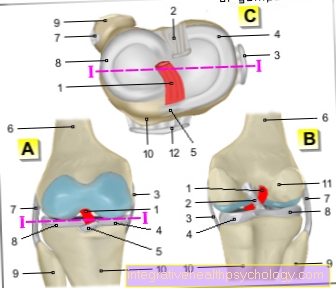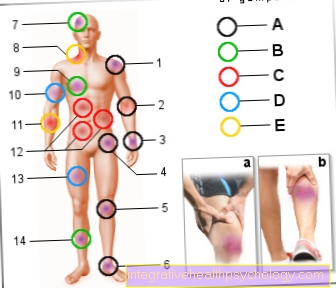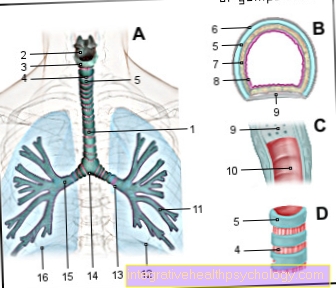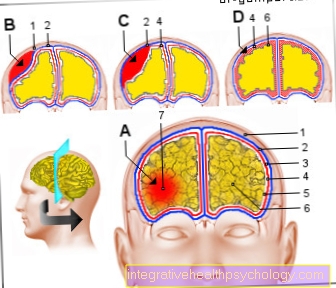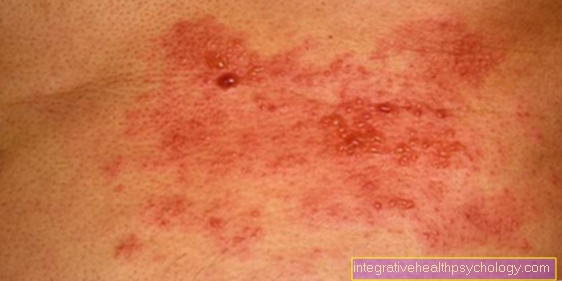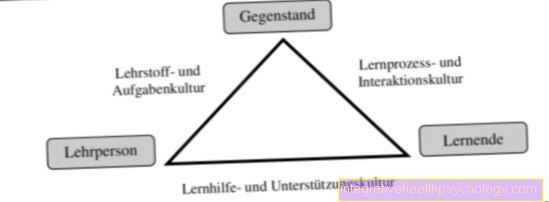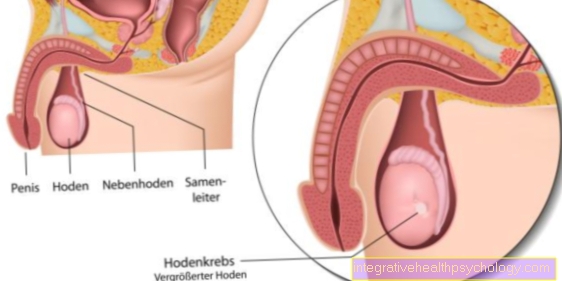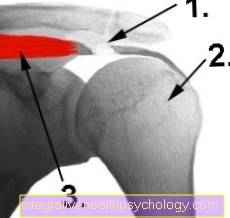Peroneal palsy
introduction
Under one Peroneal palsy one understands a paralysis of the Common peroneal nerve, also Common fibular nerve called.
This is one Leg nerve, which runs from the knee to the foot and, together with other nerves, ensures that the lower leg is mobile. It also ensures the sensitivity of the patient in the area of the lower leg so that they can feel pain and touches on the skin.
Of the Common peroneal nerve is a branch of the Sciatic nerve, which pulls out of the lumbar spine and then on the thigh into various nerves, such as the Common peroneal nerve, divides.

Symptoms
With peroneal palsy there are specific symptoms that are usually quite clear.
Nevertheless, it is important to differentiate whether the entire common peroneal nerve is no longer functioning properly or whether one of its sub-branches, i.e. the superficial peroneal nerve or the profound peroneal nerve, is damaged.
- If only the superficial peroneal nerve is affected, the result is numbness (sensitive deficit) from the front of the lower leg over the dorsum of the foot and along the first 4 toes, whereby the gap between the first and the second toe can still be felt in the classic way. Raising and lowering the tips of the feet works, but the patient can no longer tip their feet to the side (pronate).
- If, on the other hand, the deep peroneal nerve fails, the patient also suffers from other symptoms. Classically, the patient can no longer lift the tip of the foot properly (Dorsiflexion). Generally, the foot hangs down, which is why the patient has to pull his knees very high when running so that the foot does not drag on the floor and the patient does not trip over it. The resulting gait pattern is also referred to as stepper gait or stork gait. In addition, the patient can no longer feel anything between the big toe and the second toe that he or she might notice when wearing a flip-flop.
- If complete peroneal palsy occurs, in which both nerve parts are affected, the patient suffers from all the symptoms listed.
Read more on the topic: Fibula pain
Sensory disturbances
With a peroneal palsy there is a failure of various Lower leg and foot muscles always too Sensory disturbances.
However, depending on which of the two nerves is affected, they can feel very different.
If there is an injury or irritation of the Deep peroneal nerve, the patient has sensory disorders due to the peroneal palsy between the big toe and the second toe, i.e. exactly in the area in which a flip-flop is normally worn.
But is the Superfiscial peroneal nerve affected, the patient has sensory disorders due to the peroneal palsy The front of the lower leg and the back of the foot.
If both nerves are affected, the patient has complete peroneal palsy with sensitivity disorders in the area of the lower leg, the back of the foot and in the area of the toe gap between the first and second toes.
In general, the sensitivity disturbances in peroneal palsy are disturbing, but not as serious as the fact that the patient can no longer lift the foot properly because the muscles can no longer be properly addressed by the nerve.
This then leads to the typical Stork gangwhich is much more noticeable than a sensory disturbance due to the peroneal palsy between the first and second toes.
causes
There are several causes of peroneal palsy.
A common cause is a so-called iatrogenic damage to the peroneal nerve. This means that medical action (for example during a surgery) was damaged and the cause of the paresis can thus be traced back indirectly to the doctor.
Another cause of peroneal palsy can be a accident (Trauma), for example a traffic accident in which the patient is the knee or the Thigh injured.
This can result in damage to the fat and muscle tissue (soft tissue damage) Increase in pressure on the nerves come, which in turn can damage it.
Also one Bleeding can lead to increased pressure being exerted on the nerve and thus to (temporary) peroneal palsy.
Still a break in the Fibula bone (Fibula) or a dislocation of this bone (dislocation) can be a cause of peroneal pressure, although this does not always have to occur.
Another cause of peroneal palsy is a too tight cast in question. This can press on the nerve from the outside and cause it to be damaged.
Only in rare cases is a tumor responsible for the constriction of the nerve, which is then to be regarded as the cause of peroneal palsy.
Another cause of peroneal palsy can be a Herniated disc of the lumbar spine This usually affects not only the peroneal nerve but also other nerves. Therefore the symptoms are much more general and the failure symptoms relate to larger areas.
Peroneal palsy after hip surgery
In rare cases, peroneal palsy may occur after a Hip surgery come.
This is especially the case if it is during hip surgery unforeseen complications gave that lead to the Peroneal nerve or the Sciatic nerve have been irritated or injured.
The likelihood of peroneal palsy after hip surgery is very low, but due to the particular location of the nerve, the doctor may inadvertently damage the nerve.
The peroneal palsy is often after the hip operation only temporarily and can be remedied with the help of physiotherapy and targeted training, but there are also cases in which the peroneal palsy persists after the hip operation and thus a permanent weak foot lifting caused.
In general, the risk of peroneal palsy after hip surgery is very low, but the attending physician should point out the risk to the patient, as any operation can lead to unpredictable complications, which the patient should be aware of.
Bilateral peroneal palsy
Peroneal palsy can always occur when the nerve in the lower leg has been damaged.
Usually the damage occurs one-sided on, but peroneal palsy can occur on the right and left.
In this case it is peroneal palsy particularly serious, since the patient can no longer pull both of his feet up properly, which is why it becomes the so-called Stork gang comes.
Right and left peroneal palsy urgently requires intensive physiotherapy.
diagnosis
The diagnosis of peroneal palsy can often be made in Doctor-patient conversation be asked when the patient reports the typical symptoms and symptoms of failure.
During the examination by the doctor can be based on the described Numbness The definitive diagnosis is usually made in the area of the lower leg. Only rarely does the Nerve conduction velocity can be measured, which is reduced in the case of peroneal palsy.
To one Herniated disc of the L5 disc can be excluded, however, an MRI can also be performed, as the exact differentiation between nerve damage and damage to the intervertebral disc is often difficult.
therapy
Treatment for peroneal palsy depends very much on what caused it.
It came because of something Herniated disc to a peroneal palsy, it should be corrected.
Is the cause that a Bleeding or one Water retention (edema) presses on the nerve, these causes must be eliminated so that the peroneal palsy is eliminated and the patient fully feels his lower leg again and can move it adequately again.
Was the nerve through a Pressure damage (for example a plaster of paris) can be damaged, especially the physical therapy help the patient to rebuild the muscles and stimulate the nerve so that it resumes its full function.
However, if the nerve has been severed and peroneus palsy has occurred as a result, there may be no therapy options to make the nerve fully functional again.
In this case one speaks of one irreversible, i.e. irreversible nerve damage.
In this case, the therapy is possible Consequential damage (Secondary damage), such as a Foot malposition (Equinus) to avoid. For this, the patient receives special Support railsso that the leg is in the correct position.
physical therapy
In the case of peroneal palsy physical therapy often the method of choice so that the patient can fully feel and move his lower leg and foot again.
Physiotherapy for peroneal palsy ensures that the patient rebuilds the muscles that were not used adequately due to the damage to the nerve, and that the nerve is stimulated more frequently.
As a result, physiotherapy is very successful in treating peroneal palsy. Nevertheless, it is possible that physiotherapy fails in the case of peroneus palsy.
This is always the case when the nerve has been irreversibly damaged, for example at a Nerve transection in the course of an accident.
Here, physiotherapy cannot reverse the peroneal palsy, but it can help the patient to find a way, despite the paralysis one Foot malposition to avoid and to optimize the gait pattern so that it does not lead to Stork gang comes.
It is particularly important that the physiotherapy of peroneal palsy is carried out permanently and regularly so that the patient can achieve the desired therapeutic success.
prophylaxis
In order to avoid peroneal palsy, the patient should be careful not to cross his legs permanently and in a strongly angled form, as this could lead to a Narrowing (Compression) of the nerve can come.
Furthermore, women in particular should avoid boots with a too high shaft that cut into the area below the knee.
Of course, fractures in the leg area should also be avoided.
Carrying heavy loads should also be avoided, as this leads to an incorrect load on the back and thus to Herniated discs can come.
Healing of peroneal palsy
In general, a cure for peroneal palsy is almost always possible.
This is especially true if the nerve was only damaged by pressure or by a brief event. In this case a complete cure of the peroneal palsy is possible, but it is necessary that the patient regularly attends physical therapy sessionsto aid healing. He must actively take care that the muscles are rebuilt and that the nerve is stimulated.
It comes to one prolonged irritation of the nerveFor example, if a patient wears a lower leg cast that is too tight for a long period of time, it may be that a complete healing of the peroneal palsy is no longer possible because the nerve too badly damaged and cannot regenerate completely.
In most cases, however, complete healing of the peroneal palsy is possible as long as the nerve is still intact and has not been severed.
If the nerve is severed, sufficient healing of the peroneal palsy is usually no longer possible, so that the patient has to live with this paralysis permanently and should try to repair further damage such as Misaligned feet, to avoid.
forecast
The prognosis for peroneal palsy depends very much on the cause of the nerve damage.
It came through a surgery or by one fracture If the nerve is severed, the prognosis for peroneal palsy is rather poor, as the nerve usually cannot be restored.
From now on, the patient must use physical therapy and a splint of the lower leg try to further damage like a Equinus to avoid.
However, there is another underlying cause, such as a too tight cast, the prognosis for peroneal palsy is very good, as the patient can completely reverse the paralysis with the help of physiotherapy.
The prognosis of peroneal palsy therefore depends individually on the cause of the paralysis and on the individual condition of the patient.



